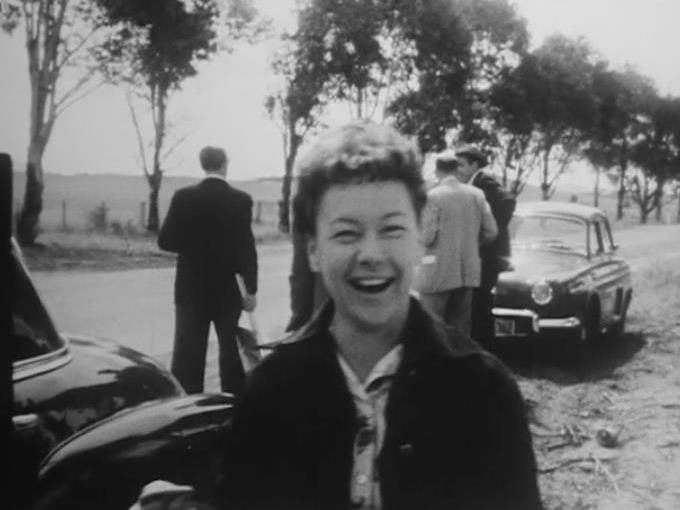Actors Equity went to Canberra in 1956 to campaign for a quota system in television. Here the long column of cars has stopped for a picnic on the road. The footage shows dozens of people who probably went on to careers on our screens – but we can identify only a handful. Can you help us with the rest?
NOTE: solutions to our puzzle will accumulate at the end of this article.
Imported TV is Crime School!
Aussies Rarely Seen on a TV Screen
Methinks Imported TV Stinks.
No Role, Actors on Dole!
These slogans appeared on the street carried by indignant actors in the first ever campaign for quotas to create a local television production industry.
The sector usually honours Hector and Dorothy Crawford for the battle to create quotas which started in 1962. But this protest was organised by Actors Equity, and it occurred in 1956.
While television was rolled out across Sydney and then Melbourne between the 16th of September and the 22nd of November, just in time for the Olympics, the only militant union in the Australian industry was already fighting for local content.
We know this because Hayden Keenan encountered a remarkable piece of footage in his research for his television series Persons of Interest. Eight minutes of high quality film of the demonstration had been acquired by ASIO sixty years ago, and ultimately sent to the National Archives of Australia where it now forms part of a special collection of ASIO films. Film activists and historians like John Hughes have used the material before, but Keenan had the opportunity to use it in his documentary and put fragments online.
Why did ASIO bother? Since the Communist Party of Australia had Australian content as part of its platform, any political activity on this front was assumed to be a cover for dirty Reds. Those Equity demonstrators were presumed to be Communist agitators.
Keenan does not know for sure how ASIO acquired the footage. It is not the long range shakey-cam usually shot by spies, and there is no sound. The people in the film clearly know they are being filmed and often posed for the camera, and it looks as if the cinematographer was a professional. It is possible that the cameraman posed as a news stringer, but Keenan believes that processing labs in both Sydney and Melbourne would turn prints of interesting scenes over to ASIO. So this may be real news footage which was clandestinely copied and filed.
The film covers a journey from Sydney to Canberra, and a march up the steps of Parliament House and into the building. We know that Leonard Teale, John Ewart and John Meillon were in the demonstration, because they were already prominent male lead actors. If you spot anyone, please email me at david@screenhub.com.au and I will add the information to the story.
Here is a short version of the footage:
asio equity protest H.264 from Smart Street Films on Vimeo.
Leonard Teale was a successful radio actor in shows like Superman, and had appeared in feature films Eureka Stockade, Call for Order and Smiley, finished just months before this demonstration. He co-compered the Argonauts in 1954 and was the first Muddle-Headed Wombat, written by Ruth Park, who did a huge amount of work for the ABC Children’s Hour despite her public left-wing sympathies.
His birth name was Thiele, but he changed it gradually in the early Fifties. He was part of the Australian Cultural Defence Movement, inspired by the Communist Party, which was publicly criticised and did not last long. It is apparently possible that he was removed from the program for political reasons.
John Ewart, had already been in Sons of Matthew as the lead role, and had been doing radio drama since he was four years old. Through the Fifties and Sixties he was the irrepressible Jimmy in the ABC Children’s Hour, part of The Argonauts and also Teale’s successor as The Muddle-Headed Wombat.
John Meillon started in radio and moved to respectable theatre at the age of sixteen, in the Shakespeare Touring Company. He went to London in 1959, did a bunch of films, came back for They’re a Weird Mob in 1965 and then into TV with My Name’s McGooley, What’s Yours? His voice was truly immortalised on Victoria Bitter ads. He truly swapped sides from theatah in the Old Dart to become an icon of the Australian vernacular.
Terry McDermott is there too. He became a fixture in early television after The Adventures of Long John Silver in 1957, but there is little information on the net about his early work. He recorded an interview in 1996 which reminds us that labour and management fought each other underneath the apparent unity.
McDermott is explaining why he stopped working on Homicide in 1965 after nine years as Det. Sgt. Frank Bronson.
A number of things happened. Lex Mitchell found out from reading the script that he was leaving the series! I think what happened was they decided to replace Lex with Leonard Teale as a threat to me.
But I ended up leaving because I wanted to. I was risking my life doing all these stunts and I didn’t even get any recognition for it, but the main stumbling block was that I wanted a new deal if they sold it overseas. They denied that they were ever going to sell it overseas, and after I walked out of the office somebody said to me “Isn’t it great, they’ve sold Homicide overseas.” After that I felt I couldn’t trust Crawfords. So that was that. They kept sending me the old contracts and I wouldn’t sign them, so then they asked if I would stay for five episodes while they wrote me out and I said I would.
lan Jones outlined exactly what the last episode was going to be, and I wanted Bronson to be killed off, I didn’t want him to be put on a shelf somewhere. And they did it in a nice way, it was quite well done. Parts of that episode were excellent, other parts were terribly over the top, but it was a very good episode to go out on. They got a lot of mail about it.
Here is the extended version of the footage.
Demonstration by Actors Equity outside Parliament in Canberra in support of Australian drama from Smart Street Films on Vimeo.
Liz Crosby left this note on the page:
At 52 secs Johnny Ewart, far right of frame, holds a ‘TV stinks’ placard; At 1.00 min Nigel Lovell in BG, 3rd from left with head tilted down; At 1.02 min Don Crosby is in centre of frame, hands clasped with cigarette in holder in his (camera left) hand; At 1.02 min Leonard Teale, holding a ‘TV stinks’ placard, stands at camera right of Don Crosby. Wish I could recognise more, wish some of this great old guard were alive to tell us!
CORRECTION: I have added some details about the history of the footage, which is already known and identified.
DISCOVERIES:
Marcia Hathaway is at 2.21 in the short version. Born in 1930 she appeared in Shadow of the Boomerang, which seems to be a US film made here with religious intent, and Harlequinade in 1961. She was a committed Christian.
Sadly, she died on Australia Day weekend in 1963, the last person to have been eaten by a shark in Sydney Harbour.
Thanks to Carolyn Lowry.
The man with the hipster beard (Yes!) is John Tate, at 0.39 to 0.46. He was born in 1915, and married fellow radio star Neva Carr-Glyn in 1940. They had one child, who went on to become Nick Tate, and a messy divorce in the early fifties, after which she continued to perform until her role in both Blue Hills and Certain Women was curtailed by her sudden death in 1975. She had a pronounced limp which was no real impediment.
John Tate was in Smithy and On the Beach in 1959, after which he left for Britain with his second wife Margaret Barton, where he performed in Day of the Triffids and did six episodes of Z Cars over eight years. He was back in Australia by the time he played in the ABC series Dynasty with his son Nick. He was in one American production, called The Autobiography of a Flea where he played an aged priest in risque circumstances. He died in 1979.
Noeline Brown spotted him. She was in My Name’s McGooley, What’s Yours like John Meillon, and The Mavis Bramston Show on the way to being in everything, including Walkabout. History in the making.
She also found Queenie Ashton at 5.13, complete with curls and pearls. She was already 53, as she was born in 1903 in the UK as Edith Muriel Ashton. She was on the boards from the age of fourteen as a dancer, soprano and comedian. By 1927 she was in Australian theatre, and appeared in local post war melodrama Always Another Dawn (which got Bud Tingwell going).
She was in Australia’s very first live hour long TV drama, made by the ABC in 1957 from a script by Alan Seymour from a play by John Coates. She did a lot of popular television, and was in Blue Hills for its full 27 year run. In 1987 she was in The Year My Voice Broke and kept performing almost until her death at the age of 95.
Her sharp eyes picked Wendy Blacklock at 1.57 and 4.37 in the long version. She is proudly carrying the flag and wears a fetching white hat – as Noeline says, ‘daintily decked out for a garden party’. Born in 1932, she was 24 at this time, bouncing happily along with no hint of the remarkable career to come. Although she was at the centre of the action even then.
She started with J.C. Williamsons, did light comedy for BBC radio in the late fifties, and starred (with Queenie Ashton) in a musical telemovie called Pardon Miss Westcott in 1959.
She appeared occasionally in TV until she had a run on Number 96 as Edie from 1974 to 1977. But that was a small part of her life – she was a respected theatre actress and revue performer, who disliked her box persona as a ditzy drunk and moved seriously into theatre administration. She ran Performing Lines which developed and staged new Australian work with an emphasis on Aboriginal projects and only retired at the age of 79 after 21 years.
In 2013 she gave a lecture, sitting but still cleartongued and definite, which you can find on Youtube.
I’m hoping you find more – these people are wonderful. I am dying to know who the young woman is in the lede photo.





